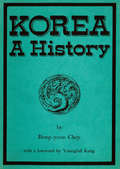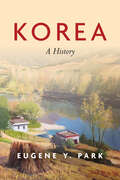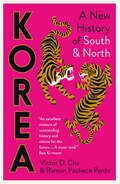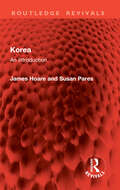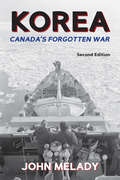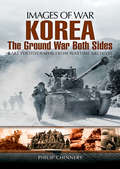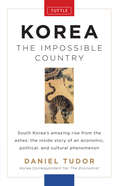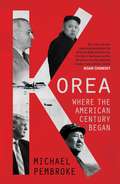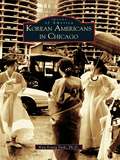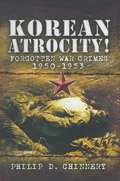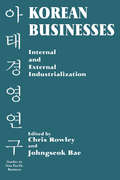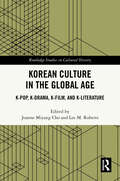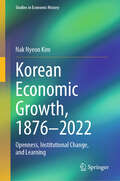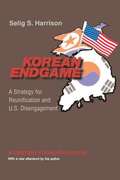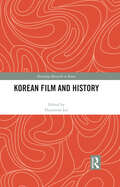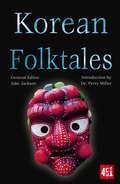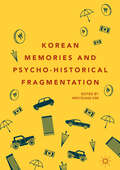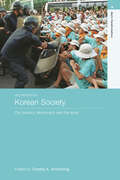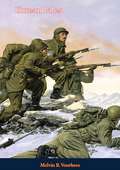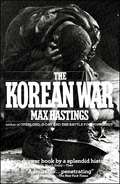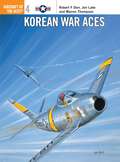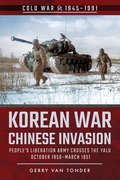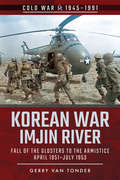- Table View
- List View
Korea: A History
by Younghill Kang Bong-Youn ChoyThis detailed, scholarly history of Korea is a comprehensive political and socioeconomic history from 57 B.C. to modern times, including North and South Korea.Specializing in Korean industrial structure, economic planning, and administration, the author presents a concise yet readable historical approach to a greater understanding of Korea's position in East Asia. The author, a political scholar and experienced linguist, bases his text on primary Korean and Japanese sources, thus providing much information previously unavailable to English-speaking people.Ancient Korea is covered in the first chapter, "The Three Kingdoms," and also in the six subsequent chapters dealing with feudalism, land reform, and early Korean social structure. The thirteen succeeding chapters bring the history to modern times. They include a valuable account of Japanese colonial policy and the struggle for independence of the Korean people; the Korean War, its development, offensives, and counteroffensives; factionalism; the politics of Syngman Rhee and his twelve years of one-man rule; the background of the student revolutions; foreign relations; nationalism and neutrality; and the important comparative studies concerning Communism and the governments of North and South Korea. The concluding chapter deals with the future of Korea and its role in rapidly changing East Asia.
Korea: A History
by Younghill Kang Bong-Youn ChoyThis detailed, scholarly history of Korea is a comprehensive political and socioeconomic history from 57 B.C. to modern times, including North and South Korea.Specializing in Korean industrial structure, economic planning, and administration, the author presents a concise yet readable historical approach to a greater understanding of Korea's position in East Asia. The author, a political scholar and experienced linguist, bases his text on primary Korean and Japanese sources, thus providing much information previously unavailable to English-speaking people.Ancient Korea is covered in the first chapter, "The Three Kingdoms," and also in the six subsequent chapters dealing with feudalism, land reform, and early Korean social structure. The thirteen succeeding chapters bring the history to modern times. They include a valuable account of Japanese colonial policy and the struggle for independence of the Korean people; the Korean War, its development, offensives, and counteroffensives; factionalism; the politics of Syngman Rhee and his twelve years of one-man rule; the background of the student revolutions; foreign relations; nationalism and neutrality; and the important comparative studies concerning Communism and the governments of North and South Korea. The concluding chapter deals with the future of Korea and its role in rapidly changing East Asia.
Korea: A History
by Eugene Y. ParkWhile popular trends, cuisine, and long-standing political tension have made Korea familiar in some ways to a vast English-speaking world, its recorded history of some two millennia remains unfamiliar to most. Korea: A History addresses general readers, providing an up-to-date, accessible overview of Korean history from antiquity to the present. Eugene Y. Park draws on original-language sources and the up-to-date synthesis of East Asian and Western-language scholarship to provide an insightful account. This book expands still-limited English-language discussions on pre-modern Korea, offering rigorous and compelling analyses of Korea's modernization while discussing daily life, ethnic minorities, LGBTQ history, and North Korean history not always included in Korea surveys. Overall, Park is able to break new ground on questions and debates that have been central to the field of Korean studies since its inception.
Korea: A New History of South and North
by Victor Cha Ramon Pacheco PardoA major new history of North and South Korea, from the late nineteenth century to the present day “Cha and Pacheco Pardo have years of expertise in Korean international relations. . . . A crisp and balanced account.”—Christopher Harding, The Telegraph Korea has a long, riveting history—it is also a divided nation. South Korea is a vibrant democracy, the tenth largest economy, and is home to a world-renowned culture. North Korea is ruled by the most authoritarian regime in the world, a poor country in a rich region, and is best known for the cult of personality surrounding the ruling Kim family. But both Koreas share a unique common history. Victor Cha and Ramon Pacheco Pardo draw on decades of research to explore the history of modern Korea, from the late nineteenth century, Japanese occupation, and Cold War division to the present day. A small country caught amongst the world’s largest powers—including China, Japan, Russia, and the United States—Korea’s fate has been closely connected to its geography and the strength of its leadership and society. This comprehensive history sheds light on the evolving identities of the two Koreas, explaining the sharp differences between North and South, and prospects for unification.
Korea: An Introduction (Routledge Revivals)
by James Hoare Susan ParesHost country to the 1988 Olympic Games, the Republic of Korea (‘South Korea’) became prominent in world affairs but surprisingly little was known about the general public. First published in 1988, Korea provides a complete picture of the country and its people. The authors reveal the continuing importance of the country’s economic development, which enabled it to develop almost overnight from a starvation economy into an international force and offer an insight into the distinct and under-appreciated cultural tradition of the Republic of Korea. They set the Korean peninsula in its Asian context and give a fascinating description of the Korean people—their society, language, customs, and religions (both old and new), the role of the family and of women, and the aspirations of ordinary Koreans as their country emerged into the international limelight. This book is a must read for students of Asian studies and history, and general readers interested in the topic.
Korea: Canada's Forgotten War
by John Melady Major-General John M. RockinghamIn this revised edition, men from the army, navy, and air force are honoured for their bravery in the Korean War. The Korean War (1950-53) forms a little-known but exciting part of Canada’s military history. The heroism and sacrifice of Canadians who fought in this conflict as part of the United Nations force has often been ignored. In this lively, anecdotal book, John Melady combines archival material and interviews with many Korean veterans. The result is a vivid, intensely human account of the war from its first days, to heroic battles such as Kapyong, to fascinating and more obscure incidents such as the Koje prison camp insurrection, as well as personal stories of doctors, POWs, and journalists who witnessed the conflict, including Pierre Berton and Rene Levesque.The men from across Canada who served and fought were forever changed by what they saw and experienced in this faraway land. Army, navy, air force all receive their share of long-overdue praise in this important book, which was originally published in 1983 but is now fully revised.
Korea: The Ground War from Both Sides (Images of War)
by Philip D. ChinneryThis illustrated history chronicles the ground combat of the Korean War through rare wartime photographs. The Korean War opened with the invasion of South Korea by the North Koreans in June 1950. Over the next three years, intense ground fighting led to heavy casualties and much suffering. This illustrated history traces the fluctuating fortunes of war from both sides. The South Koreans were saved from defeat by the arrival of the American and UN forces under General MacArthur. But the success of his offensive drew in Chinese forces who counter-attacked with hundreds of thousands of soldiers from the Peoples Volunteer Army. After a stalemate developed, no peace treaty was ever signed. Military historian Philip D. Chinnery tells the story of the Korean War through dramatic archival photographs supported with detailed captions and an informative text. Many of the images portray the brutal nature of the war, offering a unique insight into the conflict.
Korea: The Impossible Country
by Daniel Tudor[Long overshadowed by Japan and China, South Korea is a small country that happens to be one of the great national success stories of the postwar period. From a failed state with no democratic tradition, ruined and partitioned by war, and sapped by a half-century of colonial rule, South Korea transformed itself in just fifty years into an economic powerhouse and a democracy that serves as a model for other countries. With no natural resources and a tradition of authoritarian rule, Korea managed to accomplish a second Asian miracle.Daniel Tudor is a journalist who has lived in and written about Korea for almost a decade. In Korea: The Impossible Country, Tudor examines Korea's cultural foundations; the Korean character; the public sphere in politics, business, and the workplace as well as the family, dating, and marriage. In doing so, he touches on topics as diverse as shamanism, clan-ism, the dilemma posed by North Korea, the myths about doing business in Korea, the Koreans' renowned hard-partying ethos, and why the infatuation with learning English is now causing huge social problems.]South Korea has undergone two miracles at once: economic development and complete democratization. The question now is, will it become as some see Japan, a rich yet aging society, devoid of energy and momentum? Or will the dynamism of Korean society and its willingness to change-as well as the opportunity it has now to welcome outsiders into its fold-enable it to experience a third miracle that will propel it into the ranks of the world's leading nations in terms of human culture, democracy, and wealth?
Korea: Where The American Century Began
by Michael PembrokeUnless you know the history, you cannot see the future. In late 1950, the US-led invasion of North Korea failed and for the next three years the United States bombed the North&’s cities, towns and villages relentlessly. Pyongyang has been determined to develop a credible nuclear deterrent ever since. The Korean War was the first of America&’s unsuccessful military interventions post-World War II and its first modern conflict with China. It established the pattern for the next sixty years and marked the true beginning of the American century. With compassion for the people of the North and South, and understanding for the soldiers caught between the bitter winter and an implacable enemy, Michael Pembroke tells the absorbing story of Korea. It is essential reading for anyone seeking to understand why the Korean peninsula has become the nuclear flashpoint it is today.
Korean Americans in Chicago
by Kyu Young ParkKoreans first began to immigrate to Chicago at the turn of the 20th century. Drawn to the Windy City in search of a better life for themselves and their families, Korean Americans quickly began to establish what has become a thriving community that remains active and distinct. For the past 100 years, the Korean American community has contributed greatly to the growth and development of the Chicago metropolitan area-politically, culturally, and socially. In this book Korean Americans in Chicago celebrate these contributions with over 200 photographs that detail the various aspects of life within the community.
Korean Atrocity!: Forgotten War Crimes 1950–1953
by Philip D. ChinneryAs there was no clear victor at the conclusion of the Korean War, no war crime trials were held. But, as this book reveals, there is evidence of at least 1,600 atrocities and war crimes perpetrated against troops serving with the United Nations command in Korea. The bulk of the victims were Americans but many British servicemen were tortured, killed or simply went missing.Much of the carefully researched material in this book is horrific but the stark truth is that those North Koreans and Chinese responsible went unpunished for their shameful deeds.Korean Atrocity examines the three phases of this little known but bitter conflict from the POWs perspective the first phase when the two warring factions fought themselves to a stalemate, next, the treatment of POWs in North Korea and China, and finally the repatriation/post active conflict period. During the third phase it was realised that a staggering 7956 Americans and 100 British servicemen were unaccounted for. Many POWs were not released until two years after the end of hostilities. Bizarrely the US Government insisted on a news black-out on those left behind which raises questions as to what has been done to find the missing.This is a shocking, sobering and thought-provoking book.
Korean Businesses: Internal and External Industrialization (Studies In Asia Pacific Business)
by CHRIS ROWLEY; JOHNGSEOK BAEEssays in the book focus on the Korean model of industrialization and internal internationalization, organizational capabilities and management roles, and disadvantages inherent in the model. The subjects covered include corporate catch-up strategies, foreign investment, and future possibilities.
Korean Crisis and Recovery
by David T. Coe Se-Jik KimThis volume contains papers presented at a May 2001 conference in Seoul sponsored by the IMF and the Korea Institute for International Economic Policy on the Korean Crisis and Recovery. The papers examine the response to the 1997 crisis, its long-term impact on growth, and the state of financial and corporate sector reforms. Authors include academics, Korean policymakers, and IMF and World Bank staff involved in the Korean program. [from the IMF website]
Korean Culture in the Global Age: K-Pop, K-Drama, K-Film, and K-Literature (Routledge Studies in Cultural History)
by Joanne Miyang Cho Lee M. RobertsSince the late 1990s, South Korean cultural products such as pop music, TV drama, and film have shaped the country’s image around the world. This book explores these three internationally best-known media of the Korean Wave global phenomenon, along with a less commonly featured aspect, K-literature.Iconic images of South Korea today include stylish music groups like BTS and Blackpink, appealing dramas, and a range of films and digital comics (manhwa). Alongside associations with glitz and glamor are darker impressions: continuing political division, malaise over a war that never really ended. Korean Culture in the Global Age focuses on these and other facets of South Korea’s constantly changing international image to show how it has come to command worldwide attention. In recent years, readers in a growing number of languages have discovered the talent of South Korean authors through the efforts of countless translators. Showing developments in and occasional connections between themes in K-pop, K-drama, K-film, and K-literature, the book provides a more comprehensive view of contemporary South Korean culture.This volume will interest researchers and students of Korean Studies, Asian Studies, Asian American Studies, popular music, film studies, migration and diaspora studies, and world literature.
Korean Economic Growth, 1876 - 2022: Openness, Institutional Change, and Learning (Studies in Economic History)
by Nak Nyeon KimThis book provides the first comprehensive explanation of Korea’s 150 years of economic growth, from the opening of the ports to the present, based on consistently organized long-term statistics. The book also compares Korea’s experience with that of other countries. During this period, Korea experienced major systemic transitions, from a traditional society to colonial rule, and after liberation, the division between North and South Korea. East Asian latecomer nations, including Korea, rapidly closed the gap with advanced countries through learning and adaptation following their opening to the world. The book uses Korea’s case to demonstrate how institutional changes influence economic performance and explain the conditions under which rapid catch-up growth can occur or fail to occur. Korea’s high growth was achieved under an authoritarian regime with state-led industrial policies. As the limitations of this model became evident, Korea transitioned to a private-sector-led approach, facing economic crises in the process. Economic growth led to the rise of a highly educated middle class. This, in turn, surfaced demands that had been suppressed under the authoritarian regime, paving the way for democratization. Social development and fairness, long overshadowed by economic growth, became key policy agendas. Following the 1997 Asian financial crisis, Korea has faced the dual challenges of slow growth and rising inequality, driving increased calls for income redistribution and the establishment of a Korean-style welfare state. The book is divided into two parts. Part 1 explores long-term trends in Korea’s economic growth, comparing them with other countries. Part 2 provides a detailed, stage-by-stage analysis, highlighting the specific institutional and policy changes that shaped Korea’s development.
Korean Endgame: A Strategy for Reunification and U. S. Disengagement
by Selig S. HarrisonNearly half a century after the fighting stopped, the 1953 Armistice has yet to be replaced with a peace treaty formally ending the Korean War. While Russia and China withdrew the last of their forces in 1958, the United States maintains 37,000 troops in South Korea and is pledged to defend it with nuclear weapons. In Korean Endgame, Selig Harrison mounts the first authoritative challenge to this long-standing U.S. policy. Harrison shows why North Korea is not--as many policymakers expect--about to collapse. And he explains why existing U.S. policies hamper North-South reconciliation and reunification. Assessing North Korean capabilities and the motivations that have led to its forward deployments, he spells out the arms control concessions by North Korea, South Korea, and the United States necessary to ease the dangers of confrontation, centering on reciprocal U.S. force redeployments and U.S. withdrawals in return for North Korean pullbacks from the thirty-eighth parallel. Similarly, he proposes specific trade-offs to forestall the North's development of nuclear weapons and missile delivery systems, calling for the withdrawal of the U.S. nuclear umbrella in conjunction with agreements to denuclearize Korea embracing China, Russia, and Japan. The long-term goal of U.S. policy, he argues, should be the full disengagement of U.S. combat forces from Korea as part of regional agreements insulating the peninsula from all foreign conventional and nuclear forces. A veteran journalist with decades of extensive firsthand knowledge of North Korea and long-standing contacts with leaders in Washington, Seoul, and Pyongyang, Harrison is perfectly placed to make these arguments. Throughout, he supports his analysis with revealing accounts of conversations with North Korean, South Korean, and U.S. leaders over thirty-five years. Combining probing scholarship with a seasoned reporter's on-the-ground experience and insights, he has given us the definitive book on U.S. policy in Korea--past, present, and future.
Korean Film and History (Routledge Research on Korea)
by Hyunseon LeeCinema has become a battleground upon which history is made – a major mass medium of the twentieth century dealing with history. The re-enactments of historical events in film straddle reality and fantasy, documentary and fiction, representation and performance, entertainment and education. This interdisciplinary book examines the relationship between film and history and the links between historical research and filmic (re-)presentations of history with special reference to South Korean cinema. As with all national film industries, Korean cinema functions as a medium of inventing national history, identity, and also establishing their legitimacy – both in forgetting the past and remembering history. Korean films also play a part in forging cultural collective memory. Korea as a colonized and divided nation clearly adopted different approaches to the filmic depiction of history compared to colonial powers such as Western or Japanese cinema. The Colonial Period (1910-45) and Korean War (1950-53) draw particular attention as they have been major topics shaping the narrative of nation in North and South Korean films. Exploring the changing modes, impacts and functions of screen images dealing with history in Korean cinema, this book will be of huge interest to students and scholars of Korean history, film, media and cultural studies.
Korean Folktales (The World's Greatest Myths and Legends)
by Flame TreeFrom the rift valley come stories of gods, tricksters, cattle and ogres from the many peoples of East Africa.Traditional stories bring a deeper understanding of the movement of peoples across East Africa. Common roots and differences between ancient peoples create a lively portrait with their fragile, powerful gods. The modern nations of Kenya, Tanzania, Uganda, Rwanda and more inherit the folk and mythic tales of the rift valley region. Here you'll find stories of ogres and tricksters, riddles and poems, figures such as the first man (Gikuyu) and woman (Mumbi), and great heroes of history such as Liongo. This new collection is created for the modern reader. FLAME TREE 451: From myth to mystery, the supernatural to horror, fantasy and science fiction, Flame Tree 451 offers a healthy diet of werewolves and mechanical men, blood-lusty vampires, dastardly villains, mad scientists, secret worlds, lost civilizations and escapist fantasies. Discover a storehouse of tales gathered specifically for the reader of the fantastic.
Korean Memories and Psycho-Historical Fragmentation
by Mikyoung KimThis pioneering book is the first English volume on Korean memories. In it, Mikyoung Kim introduces ‘psycho-historical fragmentation’, a concept that explains South Korea’s mnemonic rupture as a result of living under intense temporal, psychological and physical pressure. As Korean society has undergone transformation at unusual speed and intensity, so has its historical memory. Divided into three sections, on lingering colonial legacies, the residuals of the Cold War and Korean War, and Korea’s democracy movement in the 1980s, Korean Memories and Psycho-Historical Fragmentation aims to tell multi-layered, subtle and lesser-known stories of Korea’s historical past. With contributions from interdisciplinary perspectives, it reveals the fragmentation of Korean memory and the impact of silencing.
Korean Society: Civil Society, Democracy and the State (Asia's Transformations)
by Charles K. ArmstrongWhile most analyses of Korean politics have looked to elites to explain political change, this new and revised edition of Korean Society examines the role of ordinary people in this dramatic transformation. Taking the innovative theme of 'civil society' - voluntary organizations outside the role of the state which have participated in the process of political and social democratization - the essays collected here examine Korea as one of the most dramatic cases in the world of ordinary citizens participating in the transformation of politics. Key topics discussed include: comparisons of Korean democratization to the experiences of post-authoritarian regimes elsewhere in the world comparisons of the theory of civil society as developed in Western Europe and America the legacy of Korea's Confucian past for contemporary politics and society close examinations of various civil society movements South Korea and North Korea. Conceptually innovative, up-to-date and timely, the new edition of this book will be an invaluable resource for students of contemporary Korea, Asian politics and the global struggle for democracy.
Korean Tales
by Melvin B. VoorheesThis book is a first-hand account, based on personal experiences and observation, of a war unique in history and vital for the future of our civilisation. Part of the book is written in the form of fictional stories, each closely based on actual events, which reveal vividly the reactions of the fighting men and of the natives of a war-torn country.“THIS is a blessed event. At last the United States Army has given birth to a top-grade writer. From the Korean war has come finally one thin volume of prose which is apt to be remembered long after we have forgotten the heroisms of Heartbreak Ridge and the frustrations of Panmunjom.”—NY Times
Korean War
by Max HastingsIt was the first war we could not win. At no other time since World War II have two superpowers met in battle.Now Max Hastings, preeminent military historian takes us back to the bloody bitter struggle to restore South Korean independence after the Communist invasion of June 1950. Using personal accounts from interviews with more than 200 vets--including the Chinese--Hastings follows real officers and soldiers through the battles. He brilliantly captures the Cold War crisis at home--the strategies and politics of Truman, Acheson, Marshall, MacArthur, Ridgway, and Bradley--and shows what we should have learned in the war that was the prelude to Vietnam.
Korean War Aces
by Chris Davey Robert DorrThe first virtually all-jet war, the conflict in Korea saw F-86 Sabres of the USAF take on MiG-15s of the North Korean and Chinese air forces. Although the Allied pilots were initially taken aback by the ability of the communist fighter in combat, sound training and skilful leadership soon enabled Sabre pilots to dominate the dogfights over the Yalu River. In all 39 F-86 pilots achieved ace status, and a number of these are profiled in this volume, as are notable pilots from the US Navy, Marine Corps and Royal Navy and, for the first time, the handful of MiG-15 aces.
Korean War—Chinese Invasion: People's Liberation Army Crosses the Yalu, October 1950–March 1951 (Cold War, 1945–1991)
by Gerry van TonderAn examination of the causes and the direct outcome of North Korea’s seemingly unstoppable thrust down the Korean Peninsula in 1950.In his first four volumes on the Korean War, the author traces the war’s progress from the North Korean invasion of June 1950, the desperate American defense of the Pusan Perimeter, General Douglas MacArthur’s daring and highly successful amphibious offensive at Inch’on, and his subsequent advance across the 38th Parallel to the Yalu River on the Chinese Manchurian borderCommunist Chinese forces, that have been secretly infiltrating North Korean territory by slipping across the Yalu from mid-October 1950, ambush a South Korean regiment in the mountains of central North Korea. This is the first of several Chinese victories over unsuspecting and overstretched South Korean and American units in the winter of 1950-1951.On November 27, 1950, Chinese leader Mao Zedong, ostensibly fearful of the consequences of hostile American forces on his country’s border along the Yalu River, orders 250,000 troops into Korea, with express orders to annihilate the UN forces. In the western half of the theater, U.S. General Walton H. Walker’s Eighth Army front along the Ch’ongch’on axis is breached, while to the east, the U.S. X Corps suffers a series of crushing defeats, including at the Chosin Reservoir, precipitating a massive evacuation from the North Korean port of Hungnam.Praise for Korean War - Chinese Invasion"An extraordinarily informative and exceptionally well written, deftly organized and presented, detailed history.” —Midwest Book Review
Korean War—Imjin River: Fall of the Glosters to the Armistice, April 1951–July 1953 (Cold War, 1945–1991)
by Gerry van TonderAn in-depth look at the disastrous consequences of misjudgment and impulsiveness by the United States during the Korean War.As of October 1950, a quarter of a million Communist Chinese troops, in twenty-seven divisions, had poured across the Yalu River into North Korea, with the singular objective of forcing General Douglas MacArthur’s United Nations troops back across the 38th Parallel and into the Sea of Japan.Shortly before midnight on April 22, 1951, to the west of the U.S. Eighth Army’s defensive front, the Chinese Sixty-third Army fell on the British 29th Brigade. On the left flank, the 1st Battalion, Gloucester Regiment (“Glosters”) held a tenuous position at a ford on the Imjin River. Despite a gallant defense, the battalion was pushed back to make a desperate but futile stand on Hill 235. On what became known as “Glosters’ Hill,” the battalion ceased to exist. It was subsequently estimated that the attacking force of 27,000 Chinese troops suffered 10,000 casualties, forcing the Chinese army to be withdrawn from the front.From August 1951 to the summer of 1952, the USAF conducted Operation Strangle in a futile and costly attempt to disrupt Chinese supply routes. In the last two years of fighting, Communist Chinese and UN forces faced each other from well-entrenched positions in hilly terrain, where mapped hill numbers were contested. From June 1952 to March 1953, a series of five hard-fought engagements took place in central Korea as the antagonists sought ownership of Hill 266, commonly referred to as “Old Baldy.” This was followed during April–July 1953 by two tactically pointless battles over Pork Chop Hill, in which the UN forces won the first battle and the Chinese the second, with both sides sustaining major casualties. On July 27, 1953, the two belligerents signed an armistice agreement, implementing a ceasefire that stands to this day. De facto, the Korean War has never ended.
